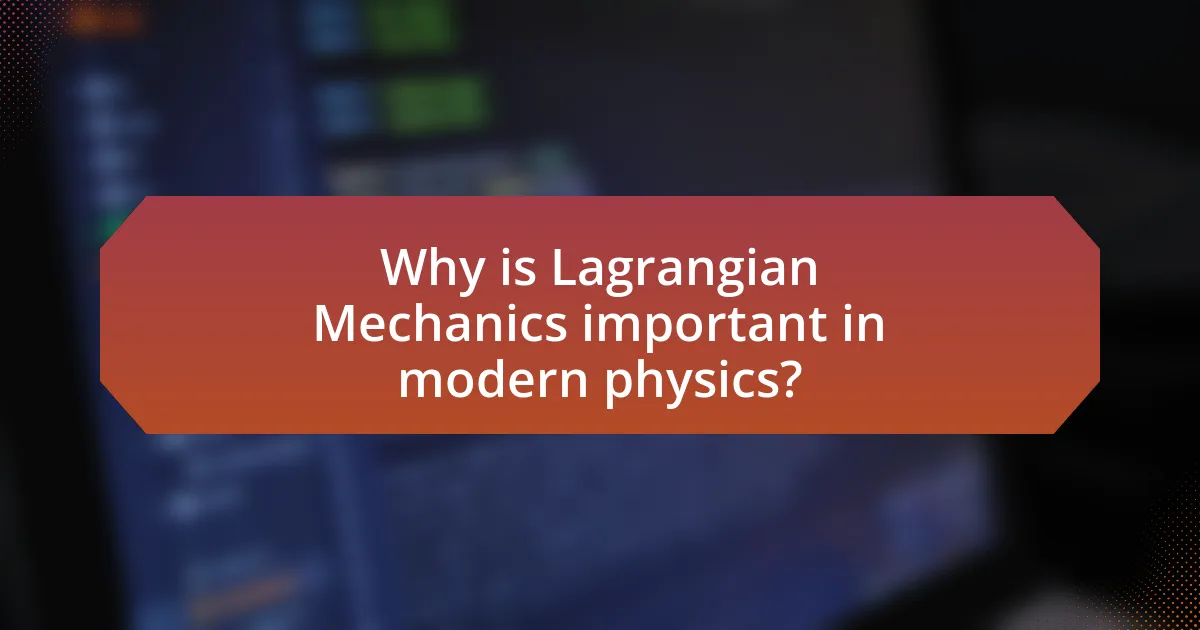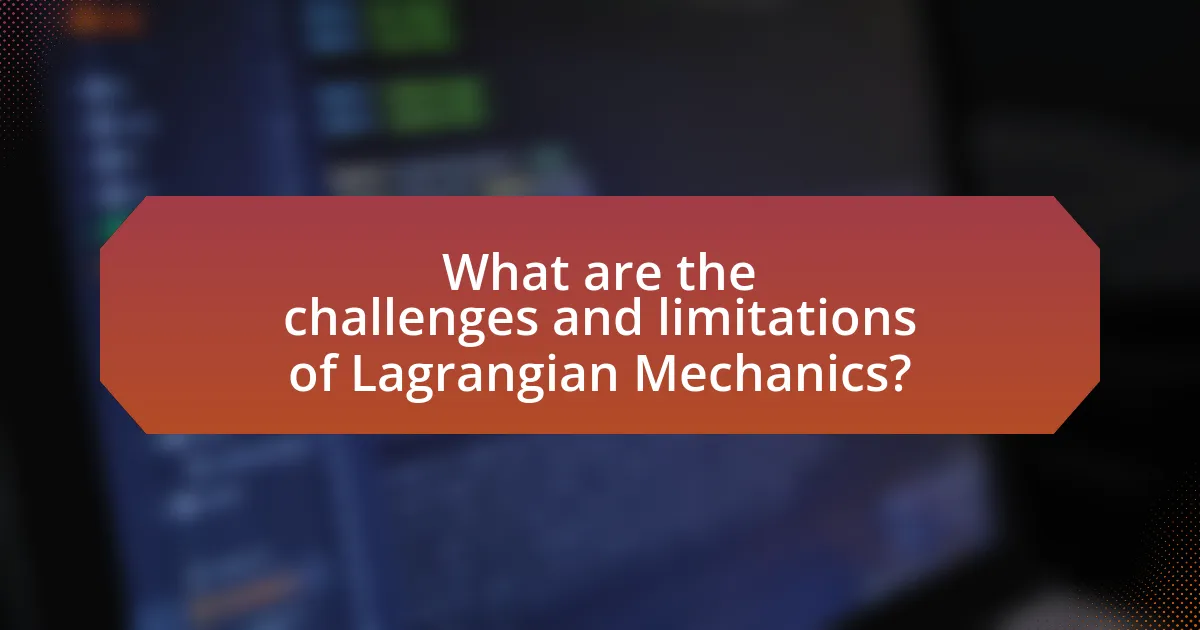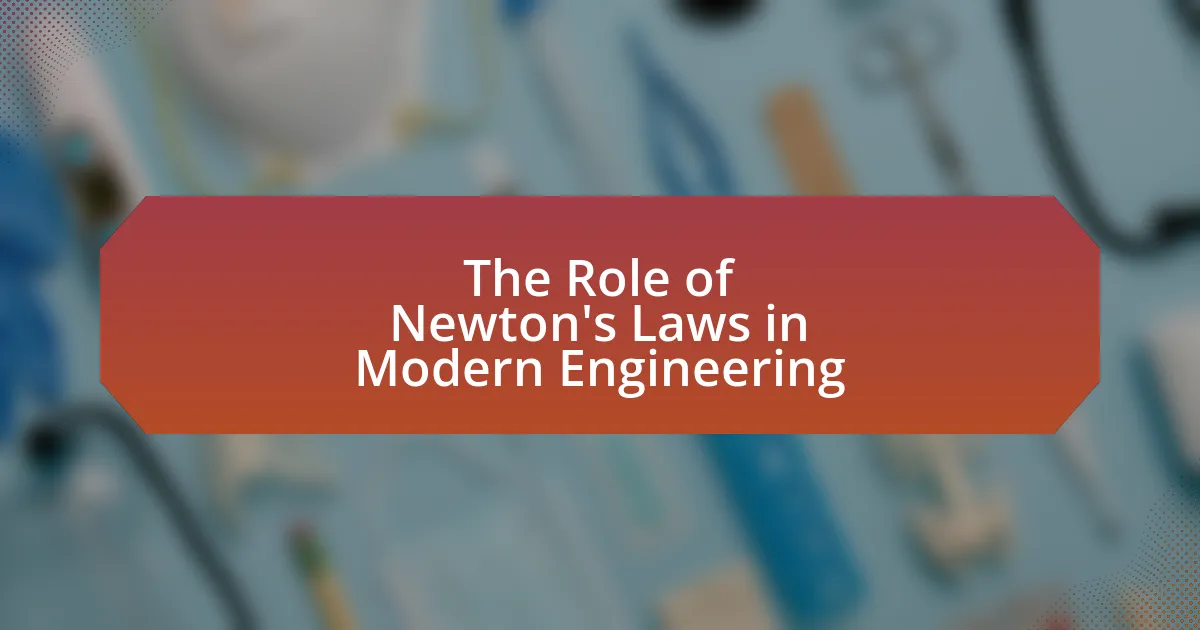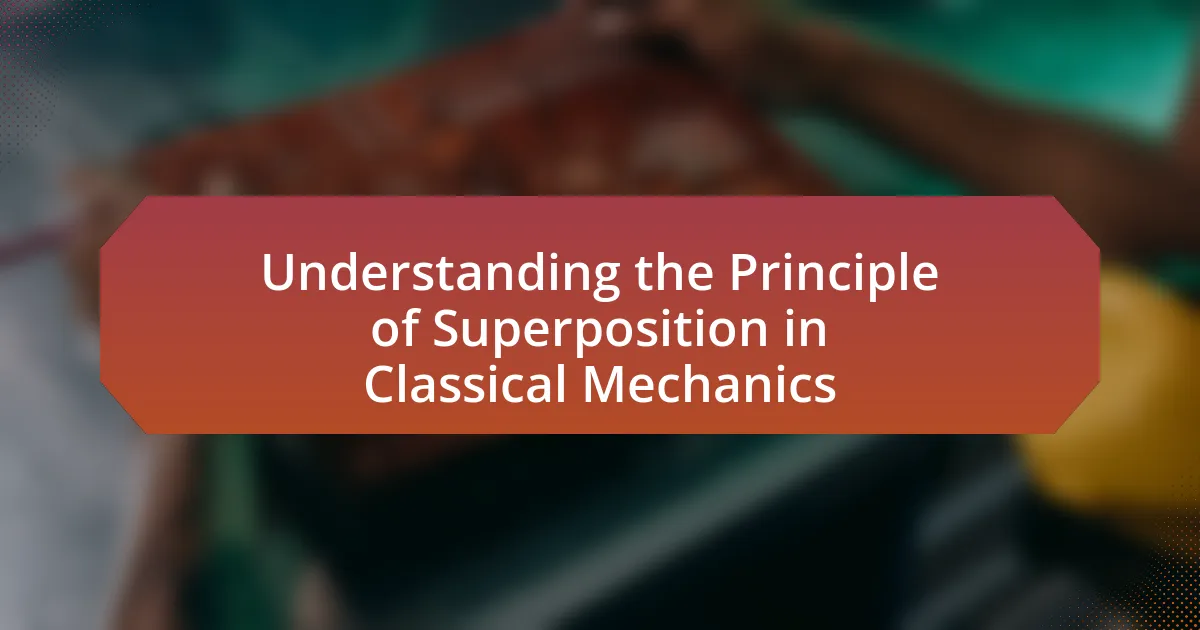Lagrangian mechanics is a reformulation of classical mechanics that utilizes the principle of least action to derive equations of motion for mechanical systems. Developed by Joseph-Louis Lagrange in the 18th century, this approach emphasizes the kinetic and potential energy of a system through the Lagrangian function, which is the difference between these energies. The article explores the distinctions between Lagrangian and Newtonian mechanics, the fundamental principles underlying Lagrangian mechanics, and its significance in modern physics, engineering, and technology. It also addresses the advantages of using generalized coordinates, the role of Lagrangian mechanics in complex systems, and its applications in fields such as robotics and aerospace engineering, while discussing challenges and misconceptions associated with this analytical framework.

What is Lagrangian Mechanics?
Lagrangian mechanics is a reformulation of classical mechanics that uses the principle of least action to derive the equations of motion for a system. This approach, developed by Joseph-Louis Lagrange in the 18th century, focuses on the kinetic and potential energy of a system, represented by the Lagrangian function, which is the difference between these two energies. The method provides a powerful framework for analyzing complex mechanical systems, particularly those with constraints, and is foundational in fields such as theoretical physics and engineering.
How does Lagrangian Mechanics differ from classical Newtonian mechanics?
Lagrangian Mechanics differs from classical Newtonian mechanics primarily in its formulation and approach to analyzing motion. While Newtonian mechanics relies on forces and the second law of motion (F=ma) to describe the dynamics of a system, Lagrangian Mechanics utilizes the principle of least action and focuses on the kinetic and potential energy of a system to derive equations of motion.
In Lagrangian Mechanics, the Lagrangian function, defined as the difference between kinetic and potential energy (L = T – V), is used to formulate the equations of motion through the Euler-Lagrange equation. This approach allows for a more generalized treatment of constraints and is particularly advantageous in complex systems, such as those involving non-conservative forces or generalized coordinates.
The validity of this distinction is supported by the fact that Lagrangian Mechanics can elegantly handle systems with constraints and is applicable in fields such as robotics and theoretical physics, where traditional Newtonian methods may become cumbersome.
What are the fundamental principles of Lagrangian Mechanics?
The fundamental principles of Lagrangian Mechanics are based on the principle of least action and the formulation of equations of motion using the Lagrangian function. The principle of least action states that the path taken by a system between two states is the one for which the action integral is minimized. The Lagrangian function, defined as the difference between kinetic and potential energy (L = T – V), allows for the derivation of the equations of motion through the Euler-Lagrange equation. This approach provides a powerful framework for analyzing complex mechanical systems, particularly in cases where traditional Newtonian mechanics may be cumbersome.
Why is the principle of least action central to Lagrangian Mechanics?
The principle of least action is central to Lagrangian Mechanics because it provides a unifying framework for deriving the equations of motion for a system. This principle states that the path taken by a system between two states is the one for which the action integral is minimized. In Lagrangian Mechanics, the action is defined as the integral of the Lagrangian function, which encapsulates the kinetic and potential energies of the system. This approach allows for the formulation of the equations of motion using the Euler-Lagrange equation, which directly arises from the least action principle. The historical significance of this principle is underscored by its foundational role in classical mechanics, as established by Pierre-Louis Moreau de Maupertuis and later formalized by Joseph-Louis Lagrange, demonstrating its validity and applicability across various physical systems.
What are the key components of Lagrangian Mechanics?
The key components of Lagrangian Mechanics are the Lagrangian function, generalized coordinates, and the principle of least action. The Lagrangian function, defined as the difference between kinetic and potential energy, encapsulates the dynamics of a system. Generalized coordinates provide a flexible framework for describing the configuration of a system, allowing for simplifications in complex mechanical problems. The principle of least action states that the path taken by a system between two states is the one that minimizes the action, which is the integral of the Lagrangian over time. These components collectively form the foundation of Lagrangian Mechanics, enabling the analysis of classical systems in a systematic manner.
What is the Lagrangian function and how is it formulated?
The Lagrangian function is a mathematical formulation used in classical mechanics to describe the dynamics of a system. It is defined as the difference between the kinetic energy and the potential energy of a system, expressed as L = T – V, where L is the Lagrangian, T is the kinetic energy, and V is the potential energy. This formulation allows for the application of the principle of least action, leading to the equations of motion through the Euler-Lagrange equation, which is derived from the Lagrangian. The Lagrangian function is foundational in both classical and modern physics, providing a powerful framework for analyzing mechanical systems.
How do generalized coordinates play a role in Lagrangian Mechanics?
Generalized coordinates are essential in Lagrangian Mechanics as they provide a flexible framework for describing the configuration of a mechanical system. They allow for the representation of complex systems using fewer variables, accommodating constraints and simplifying the equations of motion. For instance, in a pendulum system, instead of using Cartesian coordinates, a single angle can serve as a generalized coordinate, effectively capturing the system’s dynamics. This approach is validated by the principle of least action, which states that the path taken by a system is the one that minimizes the action, a concept that is elegantly expressed using generalized coordinates in the Lagrangian formulation.

Why is Lagrangian Mechanics important in modern physics?
Lagrangian Mechanics is important in modern physics because it provides a powerful framework for analyzing complex systems through the principle of least action. This approach allows physicists to derive equations of motion for a wide variety of systems, including those with constraints, by focusing on energy rather than forces. The formulation is particularly advantageous in fields such as quantum mechanics and general relativity, where traditional Newtonian mechanics becomes cumbersome. Historical developments, such as Hamiltonian mechanics, which builds on Lagrangian principles, further demonstrate its foundational role in theoretical physics.
What advantages does Lagrangian Mechanics provide in solving complex systems?
Lagrangian Mechanics offers significant advantages in solving complex systems by providing a systematic approach to derive equations of motion through the principle of least action. This framework allows for the analysis of systems with constraints more easily than traditional Newtonian methods, as it utilizes generalized coordinates that can simplify the representation of complex interactions. Additionally, Lagrangian Mechanics facilitates the incorporation of energy conservation principles, enabling the study of systems where forces may not be easily identifiable. The method’s ability to handle non-conservative forces and its applicability to various coordinate systems further enhance its utility in complex scenarios, making it a powerful tool in theoretical and applied physics.
How does Lagrangian Mechanics simplify the analysis of constrained systems?
Lagrangian Mechanics simplifies the analysis of constrained systems by allowing the use of generalized coordinates, which effectively incorporate constraints into the equations of motion. This approach transforms complex systems into simpler forms by focusing on energy rather than forces, enabling the derivation of equations that govern motion without explicitly dealing with constraint forces. For instance, in systems with holonomic constraints, the Lagrangian formulation leads to the Euler-Lagrange equations, which provide a systematic method for obtaining the dynamics of the system. This method is particularly advantageous because it reduces the number of variables and equations needed to describe the system, streamlining the analysis and making it more manageable.
What role does Lagrangian Mechanics play in fields like quantum mechanics and relativity?
Lagrangian Mechanics serves as a foundational framework in both quantum mechanics and relativity by providing a systematic approach to derive equations of motion through the principle of least action. In quantum mechanics, the Lagrangian formulation leads to the path integral formulation, where the probability amplitudes are calculated by summing over all possible paths, as established by Richard Feynman. In relativity, Lagrangian Mechanics is crucial for formulating the dynamics of systems in curved spacetime, allowing for the incorporation of gravitational effects into the equations of motion, as demonstrated in Einstein’s general relativity. This dual applicability underscores the versatility of Lagrangian Mechanics in bridging classical and modern physics.
How has Lagrangian Mechanics influenced engineering and technology?
Lagrangian Mechanics has significantly influenced engineering and technology by providing a systematic framework for analyzing complex mechanical systems. This approach allows engineers to derive equations of motion for systems with multiple degrees of freedom more efficiently than traditional Newtonian methods. For instance, Lagrangian Mechanics is foundational in fields such as robotics, where it aids in the design and control of robotic arms by simplifying the dynamics involved. Additionally, it plays a crucial role in aerospace engineering, particularly in optimizing trajectories for spacecraft, as demonstrated in the Apollo missions, where Lagrangian principles were applied to navigate and control spacecraft effectively. The versatility of Lagrangian Mechanics in handling constraints and non-conservative forces further enhances its applicability across various engineering disciplines, making it a vital tool in modern technological advancements.
What applications of Lagrangian Mechanics are prevalent in engineering disciplines?
Lagrangian Mechanics is widely applied in engineering disciplines such as mechanical engineering, aerospace engineering, and robotics. In mechanical engineering, it is used for analyzing dynamic systems, particularly in the design of mechanisms and control systems, allowing engineers to derive equations of motion efficiently. Aerospace engineering utilizes Lagrangian principles for trajectory optimization and stability analysis of aircraft and spacecraft, facilitating the design of flight paths and control strategies. In robotics, Lagrangian Mechanics aids in the modeling and control of robotic arms and mobile robots, enabling precise movement and task execution. These applications are supported by the ability of Lagrangian Mechanics to handle complex systems with multiple degrees of freedom, making it a powerful tool in modern engineering practices.
How does Lagrangian Mechanics contribute to advancements in robotics and control systems?
Lagrangian Mechanics significantly contributes to advancements in robotics and control systems by providing a systematic framework for modeling complex dynamic systems. This approach allows engineers to derive equations of motion for robotic systems efficiently, even in the presence of constraints and non-linearities. For instance, the Lagrangian formulation simplifies the analysis of multi-body systems, enabling the design of more sophisticated control algorithms that enhance the performance and stability of robotic applications. Furthermore, the use of Lagrangian Mechanics facilitates the integration of energy-based methods, which are crucial for optimizing control strategies in robotics, as evidenced by its application in the development of robotic arms and autonomous vehicles.

What are the challenges and limitations of Lagrangian Mechanics?
Lagrangian Mechanics faces several challenges and limitations, primarily its reliance on generalized coordinates, which can complicate the formulation for systems with constraints. This approach may not easily accommodate non-conservative forces, such as friction, without additional modifications. Furthermore, Lagrangian Mechanics can become mathematically intensive for complex systems, making it less practical for real-time applications. Additionally, the method is less intuitive for systems with multiple interacting bodies, where the equations of motion can become cumbersome. These limitations highlight the need for alternative methods, such as Hamiltonian Mechanics, in certain scenarios.
What common misconceptions exist about Lagrangian Mechanics?
Common misconceptions about Lagrangian Mechanics include the belief that it is only applicable to conservative systems and that it is more complex than Newtonian mechanics. In reality, Lagrangian Mechanics can be applied to non-conservative systems, such as those involving friction or external forces, as it provides a powerful framework for analyzing a wide range of physical situations. Additionally, while Lagrangian Mechanics may appear more abstract, it often simplifies the analysis of complex systems by focusing on energy rather than forces, making it a valuable tool in both classical and modern physics.
How can practitioners overcome the limitations of Lagrangian Mechanics?
Practitioners can overcome the limitations of Lagrangian Mechanics by integrating numerical methods and computational tools to solve complex systems. Traditional Lagrangian Mechanics often struggles with non-conservative forces and complex constraints, which can be addressed through numerical simulations such as finite element analysis or computational fluid dynamics. These methods allow for the modeling of systems that are otherwise analytically intractable, providing accurate solutions that account for real-world complexities. For instance, the use of software like MATLAB or Mathematica enables practitioners to apply numerical techniques to derive solutions for dynamic systems that involve multiple degrees of freedom, thereby enhancing the applicability of Lagrangian principles in practical scenarios.
What practical tips can enhance the understanding of Lagrangian Mechanics?
To enhance the understanding of Lagrangian Mechanics, one practical tip is to solve a variety of problems that apply the Lagrangian formulation to different physical systems. Engaging with diverse examples, such as the simple pendulum, double pendulum, and harmonic oscillator, allows learners to see how the principles of Lagrangian Mechanics are applied in various contexts. This approach reinforces the concept of generalized coordinates and the principle of least action, which are central to Lagrangian Mechanics. Additionally, utilizing visual aids, such as diagrams and simulations, can help clarify the relationships between forces, motion, and energy in these systems, making the abstract concepts more tangible.
How can students effectively apply Lagrangian Mechanics in problem-solving?
Students can effectively apply Lagrangian Mechanics in problem-solving by systematically identifying the system’s generalized coordinates and formulating the Lagrangian function, which is the difference between kinetic and potential energy. This approach allows students to derive the equations of motion using the Euler-Lagrange equation, which provides a powerful framework for analyzing complex mechanical systems. The effectiveness of this method is supported by its ability to simplify problems involving constraints and non-conservative forces, as demonstrated in classical mechanics literature, such as “Classical Mechanics” by Herbert Goldstein, where Lagrangian methods are shown to yield solutions that are often more straightforward than those obtained through Newtonian mechanics.
What resources are recommended for further study of Lagrangian Mechanics?
Recommended resources for further study of Lagrangian Mechanics include “Classical Mechanics” by Herbert Goldstein, which provides a comprehensive overview of the subject, and “Mechanics” by L.D. Landau and E.M. Lifshitz, known for its rigorous approach. Additionally, “Analytical Mechanics” by Fowles and Cassiday offers practical applications and problem-solving techniques. These texts are widely used in advanced physics courses and are recognized for their clarity and depth in explaining Lagrangian principles.




